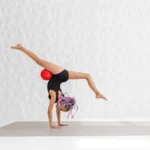Gymnastics is a demanding sport that calls for strength, flexibility, balance, and precision. While gymnasts work hard to perfect their routines, their bodies, especially their ankles, often bear the brunt of the intense movements.
The repetitive jumping, landing, and pivoting can lead to wear and tear on the ankle joints, making them prone to sprains and strains. That’s where ankle taping comes in.
1. Injury Prevention
The primary reason gymnasts tape their ankles is to prevent injuries. Gymnastics involves a significant amount of jumping, landing, and pivoting, all of which place strain on the ankles. These actions, combined with the forceful impact on the ground during floor routines, vault landings, and other elements, can lead to injuries such as sprains, strains, and even fractures.
Sprains occur when the ligaments around the ankle are stretched or torn, and strains refer to injuries involving the muscles or tendons. Both types of injuries are common in gymnastics due to the high-impact nature of the sport. Ankle taping helps stabilize the joint by limiting its range of motion, reducing the likelihood of overstretching or rolling the ankle during demanding movements.
Supporting Ligaments and Tendons
The ligaments and tendons in the ankle are essential for maintaining stability during jumps, twists, and landings. Gymnasts often tape their ankles to provide external support to these structures, especially if they have previously experienced an injury. By keeping the ankle in a controlled position, taping can reduce the risk of re-injury and provide confidence during high-intensity routines.
2. Proprioception and Joint Awareness
Proprioception refers to the body’s ability to sense its position in space. This sense is critical for gymnasts when performing precise movements that require accurate body awareness. Ankle taping enhances proprioception by applying gentle pressure around the joint, which helps the gymnast maintain better control over their foot placement during routines.
This increased joint awareness can be particularly useful during complex movements, such as landing after a jump or executing acrobatic skills on the balance beam. The taping acts as a subtle reminder to the gymnast to maintain proper form and avoid unsafe movements that could lead to injury.
3. Enhanced Stability During Landings
One of the most demanding aspects of gymnastics is the landing phase after a vault, floor exercise, or tumbling pass. Gymnasts must land with precision, absorbing the shock through their legs and feet. If the ankle is weak or unstable, there is a higher risk of misalignment, which can lead to injury.
Taping the ankle helps to provide support and stability, ensuring the gymnast can land safely and with greater control. It prevents excessive movement in the ankle joint that could lead to awkward landings and potential injuries such as sprains or fractures. In this way, taping offers both protection and a sense of security for gymnasts performing high-risk moves.
4. Recovery from Previous Injuries
Injuries to the ankle are not uncommon in gymnastics, and many gymnasts continue to compete or train even after sustaining an injury. After an ankle sprain or strain, taping can be an essential part of the recovery process. It helps reduce swelling, provides compression, and prevents further stress on the injured area.
By stabilizing the joint during recovery, ankle taping can also help to mitigate pain and discomfort, allowing gymnasts to continue training without exacerbating their injuries. It is especially beneficial when gymnasts return to full training intensity after an injury, as it provides both protection and reassurance during movements that place stress on the injured area.
5. Psychological Confidence
The psychological aspect of injury prevention cannot be overlooked in gymnastics. After sustaining an ankle injury, a gymnast may feel hesitant or less confident in their movements. Taping provides a visible and physical sign of support, both to the athlete and their coach. This sense of support can ease anxiety and boost confidence, allowing the gymnast to focus on their performance without constantly worrying about the possibility of re-injury.
The mental reassurance of knowing the ankle is protected can make a significant difference in a gymnast’s mindset, especially when performing high-risk skills or routines under pressure.
Taping Techniques: How Gymnasts Tape Their Ankles
Ankle taping can be done in various ways, depending on the specific needs of the gymnast. Some common taping methods include:
- Standard Ankle Taping
A typical method for taping involves creating a “figure-eight” pattern around the ankle, which provides stability and support to the ligaments and tendons. The tape is usually wrapped around the ankle and foot, crossing over the top of the foot and around the heel. The figure-eight pattern limits excessive inversion (turning in) and eversion (turning out) of the ankle.
- Support for Existing Injuries
If a gymnast has an existing ankle injury, a more customized taping approach may be used. For example, additional tape may be applied around the injured area to provide extra compression and support. The taping can be adjusted depending on the severity of the injury and the specific type of support required.
- Pre-Wrap or Foam Pads
Some gymnasts use a layer of pre-wrap or foam padding underneath the tape to prevent irritation and discomfort. This also helps ensure the tape adheres properly to the skin. The pre-wrap is particularly useful for gymnasts who tape their ankles frequently, as it reduces the potential for skin damage.
When Should Gymnasts Tape Their Ankles?
While taping can be beneficial, it’s important for gymnasts to know when it is necessary to tape their ankles. It is generally recommended to tape the ankle if the gymnast has a history of ankle injuries, feels instability or weakness in the joint, or is about to perform high-impact skills that could place stress on the ankle.
However, taping should not be seen as a substitute for proper conditioning and strengthening exercises. Gymnasts should also work on improving their ankle strength and flexibility to reduce the likelihood of injury in the first place. Over-reliance on taping could mask underlying issues and potentially lead to further complications.
Alternatives to Taping
While ankle taping is a common technique in gymnastics, it is not the only option. Some gymnasts prefer to use ankle braces or supports, which can offer similar stability without the need for taping. Ankle braces can be particularly beneficial for long-term use, as they are easy to apply and remove and can be adjusted for the desired level of support.
In addition, strengthening exercises for the ankles, such as resistance band exercises, calf raises, and balance training, can improve ankle stability and reduce the need for taping in the long run.
Conclusion
Taping isn’t just a precautionary measure; it’s a valuable tool in the gymnasts’ toolbox for staying strong, safe, and performing at their best. Whether it’s to prevent injuries, aid recovery, or simply enhance performance, ankle taping can make a real difference in the quality and longevity of a gymnast’s career.












